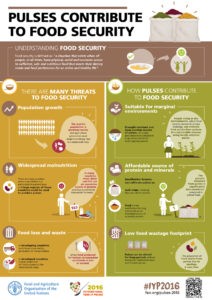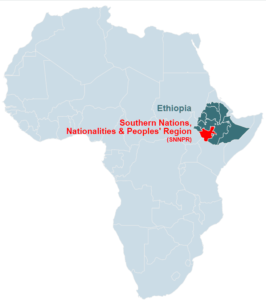International effort to provide Ethiopia with food security through pulses
 Pulses are dry edible seeds, relatively inexpensive to produce and purchase, which are chalked full of nutrients, protein, and fibre. Globally, pulses are an important crop and food source, like in Ethiopia where pulses represent ~14% of Ethiopia’s cropland. After cereals, they’re the second most important component of the national diet. Unlike North American diets, pulses are critical to the Ethiopian diet. Despite the release of many improved varieties, they’ve yet to reach their yield potential on smallholder farms. There are a number of factors for low pulse yields with the main yield gap resulting from low input usage and inaccessibility to improved varieties. Suggesting the need to effectively link agricultural research with extension systems.
Pulses are dry edible seeds, relatively inexpensive to produce and purchase, which are chalked full of nutrients, protein, and fibre. Globally, pulses are an important crop and food source, like in Ethiopia where pulses represent ~14% of Ethiopia’s cropland. After cereals, they’re the second most important component of the national diet. Unlike North American diets, pulses are critical to the Ethiopian diet. Despite the release of many improved varieties, they’ve yet to reach their yield potential on smallholder farms. There are a number of factors for low pulse yields with the main yield gap resulting from low input usage and inaccessibility to improved varieties. Suggesting the need to effectively link agricultural research with extension systems.
 Ethiopia is the third largest agriculture crop producing nation on the African continent, yet rural areas struggle with protein-calorie malnutrition and micronutrient deficiency. Fortunately, investments in child health have decreased child mortality rates. Unfortunately, Southern Ethiopia (Southern Nations Nationalities and Peoples Regional State) still struggles with stunting as anemia affects 37% of children under five. Many of these children, experience micronutrient deficiencies, specifically zinc and iron due to sub-optimal feeding practices. According to the Central Statistical Agency’s Ethiopian Demographic and Health Survey, only 2.5% of 6-23 month-old children from Southern Ethiopia consume the recommended four food groups and only 6% of children under 2 consume iron-rich foods. Although Ethiopia is a crop producing nation, a long-term plan to reduce extreme poverty, child mortality, and improve maternal health is required.
Ethiopia is the third largest agriculture crop producing nation on the African continent, yet rural areas struggle with protein-calorie malnutrition and micronutrient deficiency. Fortunately, investments in child health have decreased child mortality rates. Unfortunately, Southern Ethiopia (Southern Nations Nationalities and Peoples Regional State) still struggles with stunting as anemia affects 37% of children under five. Many of these children, experience micronutrient deficiencies, specifically zinc and iron due to sub-optimal feeding practices. According to the Central Statistical Agency’s Ethiopian Demographic and Health Survey, only 2.5% of 6-23 month-old children from Southern Ethiopia consume the recommended four food groups and only 6% of children under 2 consume iron-rich foods. Although Ethiopia is a crop producing nation, a long-term plan to reduce extreme poverty, child mortality, and improve maternal health is required.
A team of researchers and scientists feel there are solutions to improving Southern Ethiopian diets and agriculture. Through Canadian International Food Security Research Fund funding, the University of Saskatchewan and Hawassa University in Ethiopia have partnered to increase high-quality pulse crops through better varieties and improved production practices. This will encourage utilization of chickpeas and beans to reduce under-nutrition of children and reduce food insecurity.
The project’s objective is to provide food and nutrition security to smallholder farmers (70,000 farm households) through pulse innovations. In 2015 the project expanded the production of select common bean and chickpea varieties across eight districts in Southern Ethiopia. This was done through the establishment of numerous specialized seed producer farmers (one for each five surrounding farms). Farmers across these eight districts have already been provided with mini-packs of improved seed (2 kg) and bio-fertilizer. So far, 10,480 farmers have received their mini-packs and this year the project will expand to seven more districts.
Improved varieties and bio-fertilizer won’t be enough to ensure Ethiopian success. First, the project provided the science to improve the variety and conditions of farming. Now further research is needed on customer relationships, delivery channels, revenue and cost analyses, key activities, resources and partners. To do so, the project has begun to provide training on the production, application, land management and marketing on pulse crops. To help secure a greater level of success, economic and agribusiness researchers are developing appropriate business models (costs of production, storage, marketing factors, agribusiness firms, government agencies). It’s the hope that after this is understood, a plan can be put forth to ensure that pulses are adopted and improve the lives and economy of Ethiopians.
Being that 2016 marks the International Year of Pulses, this year is not about marketing a trend in food, but rather to draw attention to the importance of pulses worldwide. In North America, the role of pulses is not as intricately woven into our daily lives, while pulses are a staple of food and income in many other countries. This project to improve Southern Ethiopia’s food and nutritional security demonstrates how pulses like the common bean and chickpea could change a region’s standard of living and food security. Click the following links to learn more about this project and IDRC.
We would like to thank Prof. Bill Brown, from the University of Saskatchewan, who as the economist for ‘Scaling-up Pulse Innovations for Food and Nutrition Security (SPIFoNS) in Southern Ethiopia’ project, assisted with writing this blog.
